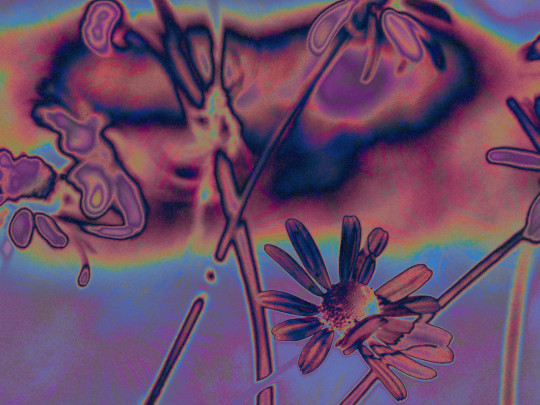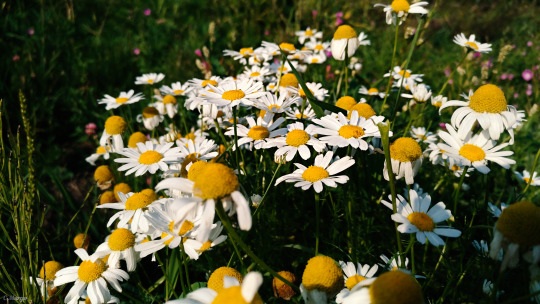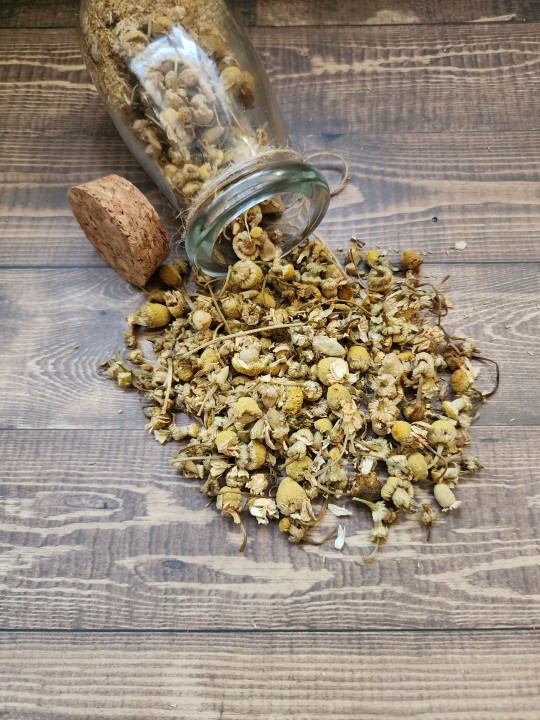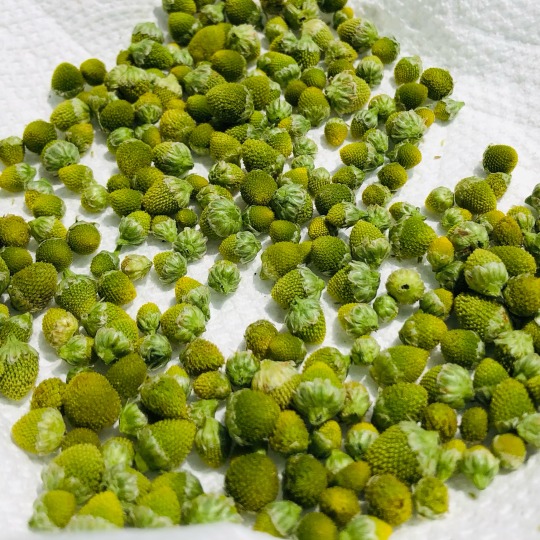#matricaria chamomilla
Text


Matricaria chamomilla is a member of the Asteraceae family, native to southern and eastern Europe.
The flowers are borne in paniculate flower heads (capitula). The white ray florets are furnished with a ligule, while the disc florets are yellow. The hollow receptacle is swollen and lacks scales.
This property distinguishes German chamomile from corn chamomile (Anthemis arvensis), which has a receptacle with scales. The flowers bloom in early to midsummer and have a fragrant aroma.
7 notes
·
View notes
Text
instagram
#illo#illustrationartists#flowerillustration#illust#illustree#gouache#womenwhopaint#prints#tdkpeepshow#itsnicethat#behance#illustratorlife#illustragram#flowerpainting#chamomile#camomile#Matricaria chamomilla#Chamaemelum nobile#Instagram
3 notes
·
View notes
Text
Tıbbi papatya nasıl ayırt edilir?
Tıbbi papatya nasıl ayırt edilir?

#Asteraceae, #Azulen, #Bisabolol, #BitkiBoyutu, #BitkiÖzellikleri, #Chamazulene, #ÇiçekBaşıŞekli, #ÇiçekRengi, #DoğalTedaviYöntemleri, #Habitat, #KimyasalBileşim, #MatricariaChamomilla, #Papatya, #PapatyaAilesi, #PapatyaÇayı, #PapatyaKokusu, #PapatyaÖzütü, #PapatyaTürleri, #PapatyaYağı, #PapatyaYağıFaydaları, #PapatyaYağıKullanımı, #PapatyaYağıYanEtkileri, #SağlıkFaydaları, #TıbbiPapatya, #TıbbiPapatyaBitkisi, #TıbbiPapatyaKullanımı, #TıbbiPapatyaNasılAyırtEdilir, #TıbbiPapatyaÖzellikleri, #TıbbiPapatyaToplama, #TıbbiPapatyaYağıKullanımAlanları, #TıbbiPapatyaYanEtkileri, #TıbbiPapatyanınFaydaları, #YağınFiyatı, #YağınKokusu, #YağınRengi, #YaprakYapısı https://is.gd/DoBEV7 https://www.tibbivearomatikbitkiler.com/blog/tibbi-papatya-nasil-ayirt-edilir/
Tıbbi papatya nasıl ayırt edilir? Biraz bundan bahsedelim ve detaylara bakalım. Tıbbi papatya (Matricaria chamomilla), papatya ailesinin (Asteraceae) bir üyesidir ve diğer papatya türlerine benzer bir görünüme sahiptir. Mayıs papatyası veya Alman papatyası diye de anılır, ancak tıbbi papatya diğer papatyalardan birkaç önemli özelliğiyle ayırt edilebilir:
Çiçek Başının Şekli: Tıbbi papatyanın çiçek başı koni biçimindedir ve içi boştur. Diğer papatyalarda ise çiçek başı daha yayvan bir yapıya sahiptir.
Yaprakların Yapısı: Tıbbi papatyanın yaprakları ince ve parlaktır. Diğer papatyalarda ise yapraklar daha geniş ve mat olabilir.
Renk: Tıbbi papatyanın çiçekleri beyaz renktedir ve ortasında sarı bir disk bulunur. Diğer papatyalarda ise çiçeklerin rengi ve disk farklı olabilir.
Koku: Tıbbi papatya, karakteristik bir elma kokusuna sahiptir. Diğer papatyalarda ise koku daha az belirgin olabilir.
Boyut: Tıbbi papatya, diğer papatyalara göre daha küçük boyutludur. Genellikle 20-30 cm boya ulaşır. Diğer papatyalar ise 50 cm’ye kadar büyüyebilir.
Habitat: Tıbbi papatya, tarlalarda, yol kenarlarında ve boş arazilerde yetişir. Diğer papatyalar ise daha çeşitli habitatlarda bulunabilir.
Tıbbi papatya ile diğer papatyaları ayırt etmek için:
Çiçek başının şekline dikkat edin. Tıbbi papatyanın çiçek başı koni biçiminde ve içi boştur.
Yaprakların yapısını ve rengini inceleyin. Tıbbi papatyanın yaprakları ince ve parlaktır ve çiçekleri beyaz renktedir.
Kokuyu test edin. Tıbbi papatya, karakteristik bir elma kokusuna sahiptir.
Boyuta dikkat edin. Tıbbi papatya, diğer papatyalara göre daha küçük boyutludur.
Habitatı göz önünde bulundurun. Tıbbi papatya, tarlalarda, yol kenarlarında ve boş arazilerde yetişir.
Eğer tıbbi papatya toplamak istiyorsanız:
Bitkinin doğru şekilde teşhis edildiğinden emin olun.
Temiz ve kirlenmemiş bir alandan toplama yapın.
Sadece çiçekleri toplayın ve yaprakları ve sapları bırakın.
Topladıktan sonra papatyaları gölgede kurutun.
Tıbbi Papatya ve Diğer Papatya Yağları Arasındaki Farklar
Tıbbi papatya yağı da diğer papatya yağlarından bazı önemli farkları ile ayırt edilir.
Kimyasal Bileşim: Tıbbi papatya yağı, diğer papatya yağlarından farklı bir kimyasal bileşime sahiptir. En önemli bileşenleri azulen, bisabolol ve chamazulene’dir. Bu bileşenler, tıbbi papatya yağına anti-enflamatuar, antioksidan, antimikrobiyal ve spazmolitik gibi birçok tıbbi özelliğini verir.
Renk: Tıbbi papatya yağı, diğer papatya yağlarından farklı bir renge sahiptir. Mavi renktedir, diğer papatya yağları ise genellikle sarı veya renksizdir. Mavi renk, chamazulene bileşeninden kaynaklanır.
Koku: Tıbbi papatya yağı, diğer papatya yağlarından farklı bir kokuya sahiptir. Hafif, tatlı bir papatya kokusuna sahiptir, diğer papatya yağları ise daha keskin veya farklı bir kokuya sahip olabilir.
Kullanım Alanları: Tıbbi papatya yağı, diğer papatya yağlarından daha geniş bir kullanım alanına sahiptir. Rahatlama ve sakinleşme, sindirim problemleri, iltihap, ağrı, cilt bakımı gibi birçok sağlık sorununa yardımcı olmak için kullanılabilir.
Fiyat: Tıbbi papatya yağı, diğer papatya yağlarından daha pahalıdır. Bunun nedeni, tıbbi papatya bitkisinin yetiştirilmesi ve hasat edilmesinin daha zor olması ve yağın kimyasal bileşiminin daha karmaşık olmasıdır.
Tıbbi papatya, çeşitli sağlık sorunları için kullanılabilir. Ancak, tıbbi papatya kullanmadan önce bir doktora danışmak önemlidir.
#Asteraceae#azulen#bisabolol#bitki boyutu#Bitki özellikleri#chamazulene#çiçek başı şekli#çiçek rengi#doğal tedavi yöntemleri#habitat#kimyasal bileşim#Matricaria chamomilla#papatya#papatya ailesi#papatya çayı#papatya kokusu#papatya özütü#Papatya türleri#papatya yağı#papatya yağı faydaları#papatya yağı kullanımı#papatya yağı yan etkileri#Sağlık faydaları#tıbbi papatya#tıbbi papatya bitkisi#tıbbi papatya kullanımı#tıbbi papatya nasıl ayırt edilir#tıbbi papatya özellikleri#tıbbi papatya toplama#tıbbi papatya yağı kullanım alanları
0 notes
Photo



chamomile flowers
photo manipulation, experimental color grading in Gimp
02.02.2023
#flowers#chamomile#matricaria chamomilla#colorful#grapic design#digital art#digital artwork#gimp#photo manipulation#color grading#color shifting#psychadelic#retro design#vintage graphic design#retro digital art#photography#digital photography#original photography#Hungary#my work#elisarde
1 note
·
View note
Text

#nature#nature core#nature photography#nature photos#naturecore#original photo blog#matricaria chamomilla#wild chamomile
0 notes
Text




Ромашка аптечная, или Ромашка лекарственная, или Ромашка ободранная (лат. Matric��ria chamomīlla).Matricaria chamomilla (synonym: Matricaria recutita), commonly known as chamomile (also spelled camomile).
#русский tumblr#Россия#природа#лето#загородом#поле#травянистое растение#цветы#Ромашка аптечная#солнечныйдень#мои фото#Russia#nature#summer#nature photography#field#flora#herbaceous plant#flowers#chamomile#flower aesthetic#sunny day#my photos#original photography#photographers on tumblr
276 notes
·
View notes
Text
herbal teas guide —
🌿🍃 having conversations with my mutuals all over the world, i was stunned to find out that not every country/culture practices drinking herbal teas for health issues. as a slavic person i decided to create this little guide because – and i'm saying this as a skeptical person who hates superstitions – they really work. 🍃🌿
mint tea (mentha piperita) is for digestion and relaxation
chamomile tea (matricaria chamomilla) is for digestive system
horsetail tea (equisetum arvense) is for skin, hair, nails condition, remineralization and circulatory system
linden tea (tilia cordata) is for a cold
lemon balm tea (melissa officinalis) is for relaxation and sleep
nettle tea (uritca dioica) is for urinary tract
sage tea (salvia officinalis) is for when your throat or teeth hurt
fennel tea (funiculum vulgare) is for digestive system
white mulberry tea (morus alba) is for carbohydrate metabolism
pansy tea (viola tricolor) is for clean skin and body detox
purge tea (cistus incanus) is for immunity
hawthorn tea (crataegus monogyna) is for heart and circulatory system
damian leaves tea (turnera diffusa) is for anxiety and libido
dandelion tea (taraxacum officinale) is for liver, stomach and digestion
st john's wort tea (hypericum perforatum) is for emotional balance, good mood, digestive system and kidney function
🌿🍃 to create this guide i was using a booklet from my pharmacy store. if you google them, you will find out that each of these have even more usage methods than the ones listed. 🍃🌿
🌿🍃 if you're from a different country/culture and you know more herbal teas like these, feel free to add them. 🍃🌿
#felt extra this evening but ive been planning to make it for a few weeks now#posted by me#slavic#polish#poland#herbs#herbal#organic#health and wellness#tea#guide
231 notes
·
View notes
Text

Chamomile
Matricaria chamomilla (shown) | Chameamelum nobile
Known as: Chamaimelon, earth apple, German chamomile, ground apple, heermannchen chamaimelon, maythen, manzanilla, Roman chamomile, scented mayweed, whig plant & wild chamomile
Related plants: There are two species of chamomile, both are in the Asteraceae family (Roman chamomile & German chamomile) with plants that consists of over 32,000 known species of flowering plants in over 1,900 genera within the order Asterales. They are commonly referred to as the aster, daisy, composite or sunflower family. I am from this point forward referring to Matricaria chamomilla in this post specifically.
Parts used: whole flower & leaves
Habitat & cultivation: This flowering plant is native to South-West Asia, Eastern & Southern Europe but can be found on almost continents nowadays. The wild-growing chamomile species normally grow on sandy to loamy soils that are mostly acidic and should be open.
Plant type: Annual
Region: 5-9
Harvest: Can be harvested as soon as blooms have established which is about 10 weeks.
Growing tips: The roots of chamomile are shallow and just barely grip onto the top soil which makes it more sensitive to water conditions during the initial stages of growth when the plant is establishing itself. However once it's established, it is drought tolerant & need about an inch of water a week. Wait until after the last spring frost to add chamomile to your garden. It grows well in raised beds, containers, and in-ground gardens. Space chamomile plants 8 inches apart in full sun for best flowering. In hot climates, an area with partial afternoon shade is ideal.
Medicinal information: Chamomile has been used as a traditional medicine for thousands of years. A mouth rinse with chamomile might relieve mouth sores caused by cancer treatments. Some research suggests that chamomile could help with other conditions, like diarrhea in children, hemorrhoids, anxiety, and insomnia. When used on the skin, chamomile might help with skin irritation and wound healing. Some research has documented that it may be as effective as hydrocortisone cream for eczema.
Cautions: Most experts say chamomile is safe. It can cause drowsiness and, in large doses, vomiting. It also has the potential to trigger allergic reactions in people who are allergic to related plants in the daisy family, although such reactions are very rare. Given the lack of evidence about its long-term safety, chamomile is not recommended for people who are pregnant or chestfeeding.
Magickal properties
Gender: Masculine
Planet: Sun
Element: Fire
Deities: Cernunnos, Karnaya, Mercury, Oshun, St.Anne & Sun gods
Magical uses:
• Burn as an incense to aid in sleep and meditation
• Plant around your house to ward against psychic or magickal attacks
• Wash your hands with chamomile before gambling to ensure good luck
• Use in an infusion to wash your thresholds to stop unwanted energies from passing through
• Place the flowers in your wallet to attract money
• Keep in a satchet to protect against physical or magickal danger
• Add to a dream pillow with lavender to ensure peaceful sleep
• Anoint a green candle with crushed chamomile for a simple money spell
• Steep in hot water, then sprinkle around yourself as a metaphysical barrier
• Add to spells to increase the chances of success
• Use in ritual baths with catnip and rose to attract a lover
• To alleviate overwhelming emotions, you can hold dry chamomile in your hands as you recite affirmations or prayers to ease the heart
#herb of the week#herbalism#magical herbs#chamomile#german chamomile#grimoire#book of shadows#witch#wiccablr#paganblr#witchblr#witchcraft#witch community#witches of tumblr#tumblr witch#baby witch#beginner witch#witch tumblr#witch tips#beginner witch tips#witchyvibes#witchcore#witches#spellbook#spellwork#spells#green witchery#green witchcrafts#green witch#traditional witchcraft
287 notes
·
View notes
Text

Litha, Summer Solstice, Midsummer – circa June 22
Litha 2024: A Witches Guide to the Pagan Summer Solstice Celebration
Litha, also known as the Summer Solstice, is a pagan holiday celebrated on or around June 21st in the Northern Hemisphere. It is the longest day and shortest night of the year, and marks the official start of summer. Litha stands as one of the four 'lesser sabbats,' marking the pinnacle of the solar calendar. In pagan traditions, it is a time to celebrate the power of the sun and the abundance and growth of the natural world. It is also seen as a time of balance between light and dark, and a turning point in the year when the days begin to grow shorter and the nights longer. This holiday is a time of abundance, growth, and light, and is associated with a variety of correspondences, including colours, crystals, deities, traditions, and ways to observe the holiday.
When is Litha 2024
Litha celebration will land on June 20, 2024 in the Northern Hemisphere. In the Southern Hemisphere, Litha, or the summer solstice, occurs around December 21st or 22nd. This is when the Southern Hemisphere experiences the longest day and the shortest night of the year, marking the official beginning of summer.
How to Pronounce Litha
Litha pronunciation is "LEE-thuh" with the emphasis on the first syllable. The word "Litha" is believed to have originated from the Anglo-Saxon word for "midsummer" and is still used by modern pagans and Wiccans to refer to this holiday.
Litha Meaning
As a spiritual holiday, Litha is a time for rituals and ceremonies that honour the sun and the energy of the summer season. It is a time to connect with the natural world and to celebrate the beauty and diversity of life. It is also a time to reflect on personal growth and to set intentions for the rest of the year.
Overall, the meaning of Litha is one of joy, abundance, and connection to the natural world. It is a time to celebrate the light and warmth of the sun, and to embrace the energy of growth and transformation that comes with the summer season.
Litha Colours
The colours typically associated with Litha include yellow, gold, green, and blue. Yellow and gold represent the sun, which is at its strongest and brightest during this time of year. Green represents growth and abundance, while blue represents the sky and the waters of life.
Litha Herbs
Litha, or the summer solstice, is associated with a variety of herbs that symbolize the energy, growth, and warmth of the season. Here are some herbs commonly associated with Litha:
St. John's Wort (Hypericum perforatum): This herb is often associated with the summer solstice and is believed to have protective and healing properties. It's in full bloom around this time.
Lavender (Lavandula spp.): Known for its calming and soothing properties, lavender is often used during Litha rituals to promote relaxation and spiritual connection.
Mugwort (Artemisia vulgaris): Mugwort is associated with psychic awareness and protection. It's sometimes used in divination practices during Litha.
Chamomile (Matricaria chamomilla): Chamomile is known for its calming properties and is often associated with relaxation, making it suitable for Litha rituals focused on introspection and meditation.
Rose (Rosa spp.): Roses are symbols of love and passion and are often associated with the sun. They can be used in rituals or as decorations to bring beauty and positive energy.
Lemon Balm (Melissa officinalis): Lemon balm is associated with the sun and is believed to attract love and positive energy. It has a refreshing and uplifting scent.
Mint (Mentha spp.): Mint is often associated with prosperity and vitality. It can be used in rituals to bring abundance and refresh the energy.
Sage (Salvia officinalis): Sage is known for its cleansing properties. It can be used to purify a space before Litha rituals or celebrations.
Yarrow (Achillea millefolium): Yarrow is associated with courage and protection. It's often used in rituals to enhance personal strength and resilience.
Calendula (Calendula officinalis): Calendula, with its vibrant yellow and orange petals, is associated with the sun and is often used in rituals for joy and positive energy.
These herbs can be used in various ways during Litha, such as in incense, sachets, wreaths, or as offerings in rituals.
Flowers for Litha
Flowers are an important part of the Litha celebration. You can use them to decorate your altar, make flower crowns, or simply enjoy their beauty as a reminder of the abundance and growth of the summer season. Some flowers that are commonly associated with Litha and the summer solstice include:
Sunflowers: These vibrant flowers are often associated with the sun and the power of light.
Roses: With their beautiful blooms and sweet fragrance, roses are a symbol of love, beauty, and passion.
Lavender: This fragrant herb is often associated with relaxation, purification, and healing.
Marigolds: These bright orange and yellow flowers are often used in rituals to honour the sun and the power of fire.
Daisies: These simple yet cheerful flowers are a symbol of innocence, purity, and new beginnings.
Chamomile: This delicate flower is often used in rituals to promote calmness, relaxation, and restful sleep.
Yarrow: This herb is often associated with courage, strength, and protection.
Crystals:
Many crystals are associated with Litha, including citrine, sunstone, tiger's eye, and amber. These stones are said to bring warmth, abundance, and vitality, and can be used in a variety of ways during Litha rituals and celebrations.
Deities:
There are a variety of deities associated with Litha, depending on your spiritual tradition. Some popular options include the goddesses Brigid, Gaia, and Freyja, as well as the gods Lugh, Apollo, and Helios. These deities are often associated with the sun, fire, and growth, and can be called upon to bring blessings and abundance during Litha celebrations.
Litha Tarot Cards
While there isn't a specific set of tarot cards exclusively associated with Litha, the themes and energies of the summer solstice can be reflected in certain cards. Here are some tarot cards that might resonate with the themes of Litha:
The Sun (XIX): The Sun card is one of the most direct associations with the energy of Litha. It represents positivity, success, and the height of vitality. It signifies the triumph of light over darkness.
The Emperor (IV): The Emperor card is associated with structure, order, and leadership. It can symbolize the power of the sun in providing stability and guidance during the height of summer.
The Empress (III): The Empress represents fertility, abundance, and growth. It is a card that aligns well with the themes of the summer season when nature is flourishing.
The Wheel of Fortune (X): This card represents cycles and the turning of the seasons. It can symbolize the natural order of life and the changes that come with each season, including the transition from spring to summer.
The Ace of Wands: Wands in the tarot often represent fire and energy. The Ace of Wands, in particular, signifies new beginnings, inspiration, and the spark of creativity—qualities associated with the active and vibrant energy of summer.
The Nine of Cups: Known as the "Wish Card" or "Happiness Card," the Nine of Cups represents emotional fulfillment and contentment. It can be seen as a card of celebration, aligning well with the joyous atmosphere of Litha.
The Lovers (VI): The Lovers card represents harmony, unity, and the coming together of opposites. It can be interpreted as a card of balance and connection, reflecting the balance of light and darkness during the summer solstice.
The Four of Wands: This card is often associated with celebrations, achievements, and a sense of community. It can represent the joyous gatherings and festivities that often accompany the summer season.
Remember, tarot is a highly personal and intuitive practice. Feel free to choose cards that resonate with you and the specific aspects of Litha that you wish to focus on in your readings and rituals.
Traditions:
There are many different ways to observe Litha, depending on your personal beliefs and traditions. Some common practices include:
Lighting bonfires or candles to celebrate the light and warmth of the sun
Decorating altars and sacred spaces with flowers, herbs, and other symbols of growth and vitality
Holding outdoor rituals or gatherings to connect with nature and honour the turning of the seasons
Creating and sharing meals made with fresh, seasonal ingredients
Participating in activities that celebrate creativity, such as dancing, singing, or making art.
Witches' Sabbath
Zakuro Aoyama
29 notes
·
View notes
Photo








Matricaria chamomilla
and
Quercus robur
(I totallly ruined some shapes and proportions here. but originally had lack of paper so I have been using one sheet of paper for multiple “frames” and... well I tried to fix it on pc... and wasn’t able to fix everything properly~~~~ uuuuh)
#don't starve#dont starve#don't starve together#dont starve wilson#Wilson P. Higgsbury#wilson percival higgsbury#Maxwell Carter#maxwil#knock art
124 notes
·
View notes
Note
if daisy were to take a clan name, is there a clanmew word for an actual daisy she could switch to? i know the cats couldn't actually make the connection that the human word = a type of flower, but i'm interested to know if daisy has an equivalent!
There's actually a whole bunch she could have picked from!! She very specifically chose to keep her Seamew name.
In Clanmew, "Daisy" even has a generic term. White flowers with a yellow button are called Osma. There are SEVEN major types of daisies that Clan cats encounter on a regular basis, and usually, only Clerics can reliably tell them all apart.
Most cats in a Clan will just be familiar with their uses.
Lawn Daisy (Bellis perennis) = Os'hap
This is the most common daisy, a widespread flower that closes up at night.
Moon Penny (Leucanthemum vulgare) = Rashma
Also called an "ox-eye daisy," or "invasive bastard weed" in American English, Clan cats HATE this plant because it makes animals that eat it taste funny. It's also FULL of pollen and very hard to get rid of in a meadow, giving some cats allergic reactions. Its name comes from Sneeze + Daisy.
Feverfew (Tanacetum parthenium) = Hakma
It is said that when StarClan saw the Clans beginning to hate daisies because of the noxious Moon Penny, they devised a plan to create a daisy that would be just as beloved as it was hated. Feverfew, the helpful herb used for treating illness, was one of their gifts.
Pellitory (Achillea ptarmica) = Waso
Their other idea was pellitory, which tastes weird, and ShadowClan loved it immediately. It has a sort of minty, numbing, hard-to-describe taste (ever had szechuan pepper? it's like that) which means that it goes RIGHT into the soup when it's found. Pellitory My Beloved.
Mayweed (Tripleurospermum inodorum) = Bleshma
"Waste Daisy." Has no particular use or nice smell. Used mostly by Clerics as a word to distinguish daisies that have no use in medicine, but it's the word that sticks when a Cleric assistant (like Brightheart) is describing various daisies to other cats.
Chamomile (Matricaria chamomilla) = Gomgon
A VERY high-strength herb, which is eventually discovered to be a very important way to treat severe epilepsy. Toxic to cats otherwise, and can be used as a poison by a skilled Cleric.
Shaggy Soldier (Galinsoga quadriradiata) = Flosk
An odd daisy with dozens of tiny flowers where its button should be. Remarked to look like a honeycomb.
54 notes
·
View notes
Text


I’m drying some pineapple weed flowers. They grow all over my local public park this time of year so I always try to collect some when I go on walks there.
Also known as “wild chamomile”(Matricaria discoidea) it is closely related to conventional chamomile (Matricaria chamomilla) and has similar culinary uses. The whole plant is edible. The leaves taste nice but they’re really fibrous so they aren’t great in salads unless you really love chewing. It gives off a sweet smell when crushed. The scent is regarded as somewhere between that of pineapple and chamomile, hence the plant's common names.
I’d like to flavor some mead with these.
12 notes
·
View notes
Text



M – Matricaria chamomilla L. – Camomilla comune (Asteraceae)
36 notes
·
View notes
Text

10 notes
·
View notes
Text
Liste non-exhaustive de plantes et de leurs effets pour enrichir ses récits
Plantes Médicinales
1. Lavande (Lavandula) : Apaisante, aide à combattre l'insomnie et le stress.
2. Millepertuis (Hypericum perforatum) : Antidépresseur naturel, aide à soulager la dépression légère à modérée.
3. Arnica (Arnica montana) : Anti-inflammatoire, utilisée pour soulager les douleurs et les ecchymoses.
4. Ginkgo Biloba : Améliore la circulation sanguine et la fonction cognitive.
5. Valériane (Valeriana officinalis) : Sédatif naturel, aide à traiter l'insomnie.
6. Sauge (Salvia officinalis) : Antiseptique, aide à la digestion et soulage les maux de gorge.
7. Eucalyptus (Eucalyptus globulus) : Antiseptique, aide à dégager les voies respiratoires.
8. Gingembre (Zingiber officinale) : Antiémétique, favorise la digestion, soulage les nausées.
9. Thym (Thymus vulgaris) : Antiseptique, aide à lutter contre les infections respiratoires.
10. Camomille (Matricaria chamomilla) : Calmante, aide à la digestion et à réduire l'anxiété.
Plantes Toxiques ou à Effets Particuliers
11. Absinthe (Artemisia absinthium) : Utilisée pour produire l'absinthe, a des effets psychoactifs controversés.
12. Datura (Datura stramonium) : Hallucinogène, extrêmement toxique.
13. Belladone (Atropa belladonna) : Toxique, contient de l'atropine qui peut être mortelle.
14. Ricin (Ricinus communis) : Contient la ricine, un poison mortel.
15. Ciguë (Conium maculatum) : Toxique, a été utilisée pour l'exécution de Socrate.
16. Pavot somnifère (Papaver somniferum) : Source d'opium, utilisé pour produire des analgésiques.
17. Aconit (Aconitum napellus) : Très toxique, connu comme "casque de Jupiter".
18. Tabac (Nicotiana tabacum): Contient de la nicotine, un stimulant addictif.
19. Jusquiame noire (Hyoscyamus niger) : Hallucinogène, toxique.
20. Lierre grimpant (Hedera helix) : Irritant cutané, les baies sont toxiques si ingérées.
#creative writing#writers on tumblr#writing#writingprompts#writers#my writing#writing ideas#writing inspiration#writerscommunity#writer things
7 notes
·
View notes
